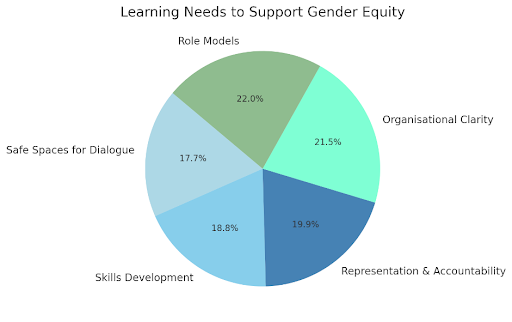Gender equity in the workplace remains a critical yet challenging goal. While its benefits – enhanced culture, innovation and morale – are widely acknowledged, tangible progress lags. Indeed, the World Economic Forum (2024) projects full gender parity is over five generations away.
While empowering women is crucial, engaging men as allies and partners is equally vital. After all, men still hold most leadership roles so their active allyship is necessary to challenge systemic biases, advocate for equitable practices, and mentor diverse talent. Engaging men helps ensure gender equity becomes a shared priority rather than an isolated effort.
Barriers to men’s engagement with gender equity in the workplace
A Hult Ashridge study of male employees in a European region of a multinational company revealed significant gaps in awareness and engagement regarding gender equity initiatives:
- Only 10% of targeted men participated in the survey, mainly senior or middle managers, showing limited involvement across levels.
- Many respondents were unaware of company gender equity policies, with 45% leaving related questions unanswered.
- Emotional responses ranged from frustration with persistent gender discrimination to empathy and a desire for change. Yet barriers like fear of “saying the wrong thing,” discomfort with challenging norms, and concerns about perceived biases hindered participation.
Learning needs for men supporting gender equity
Despite these obstacles, respondents widely recognised the importance of gender equity. They noted its positive impact on culture, innovation and morale, while expressing a need for guidance and tools to support their involvement.
Other key highlights:
- 41% highlighted the importance of leaders modeling equitable behaviours, as visible role models provide both inspiration and practical examples
- 40% emphasised the need for clear goals and strategic objectives
- 37% stressed the importance of policies ensuring equal representation of women in leadership, supported by transparent metrics
- 35% sought opportunities to lead inclusive conversations and understand allyship
- 33% desired safe spaces to explore gender equity topics without fear of judgment
Figure 1

Preferred learning methods
Respondents highlighted several preferred methods for learning and development, with face-to-face programmes emerging as the top choice.
Mentoring and on-the-job learning were also important, with many respondents emphasising the benefits of practical, hands-on experiences supported by mentors.
Coaching was preferred by 50 respondents, who highlighted the value of individualised guidance to build skills and confidence.
Additionally, some participants expressed a preference for blended learning programmes that combine in-person and digital approaches, offering maximum flexibility and impact.
Figure 2

How can organisations overcome barriers to engagement in gender equity?
A key challenge in advancing gender equity is the reluctance many men feel about engaging with these initiatives. Our study highlighted several factors contributing to this hesitancy, including fear of saying the wrong thing, lack of awareness, and perceived threats to their status.
Societal norms often make discussions uncomfortable, particularly when they challenge traditional gender roles. Some men feel stigmatised or view equity conversations as personal attacks. Others struggle to see their relevance due to limited exposure or personal experiences. Additionally, perceptions of bias or overly aggressive approaches can further discourage participation.
Here are three ways organisations, and their learning and development teams, can tackle these barriers to gender equity engagament.
1. Reduce the fear
To address these barriers, organisations must adopt targeted strategies to build confidence, foster empathy, redefine traditional norms, and create environments where vulnerability is embraced. Training programmes that equip men with practical tools and knowledge can reduce fear and enable thoughtful engagement. This, in turn, can foster a culture where men feel empowered to contribute meaningfully.
2. Bring the issue to life
Sharing real-life stories and data about the impacts of inequity can deepen empathy and shift perceptions of gender equity from being a women’s issue to a shared responsibility. Encouraging men to embrace allyship and inclusive leadership helps redefine masculinity. It also promotes qualities like empathy, openness, and equity-focused decision-making.
3. Encourage honest dialogue
Normalising vulnerability is also key. Safe spaces for exploring biases and privileges enable honest dialogue and critical self-reflection. This helps men understand their role in systemic inequities.
By implementing these interventions, organisations can empower men to engage meaningfully, paving the way for a more inclusive workplace.
Recommendations for learning and development
Tailoring learning and development programmes to address these barriers is crucial but challenging.
Prioritise targeted actions to help organisations foster meaningful engagement
For instance, tailored training programmes on unconscious bias, inclusive leadership, and gender-conscious communication can equip men with the skills to navigate equity discussions confidently.
Ensure leaders are held accountability
Managers must be held responsible for promoting diverse talent and fostering inclusive practices.
Provide allyship frameworks with practical guidance on mentoring and advocacy
This can empower men as active allies. Furthermore, recognising and celebrating male employees who champion equity initiatives reinforces positive behaviours and inspires broader participation.
It’s time to empower men to close the gender equity gap
Achieving gender equity is a complex challenge requiring persistent effort and active participation, especially from men in leadership roles. Whilst our study highlights engagement gaps, it also reveals a strong willingness among men to contribute when given proper guidance.
By addressing these needs and fostering a culture of allyship, organisations can create workplaces where equity thrives. This journey is not just about policy changes. It is about cultural shifts, personal commitment and collective effort, ensuring everyone benefits from fairness and inclusivity.





